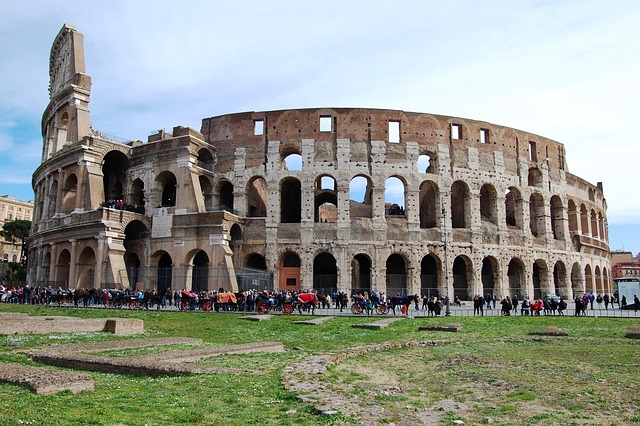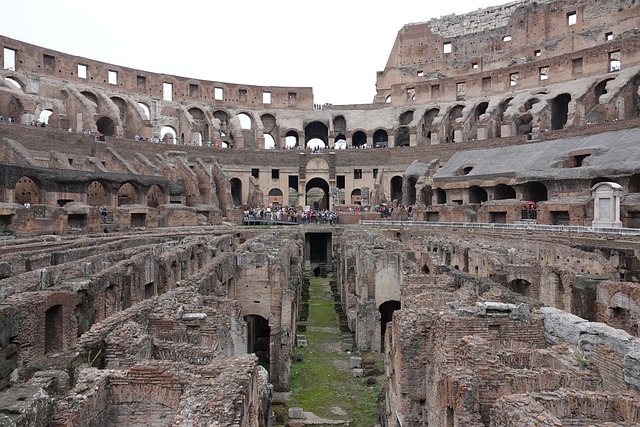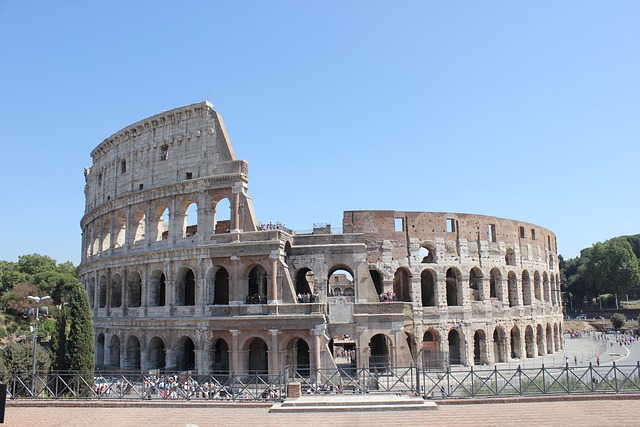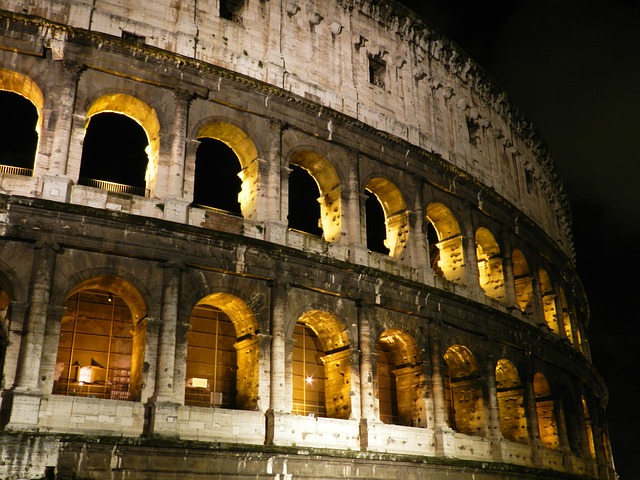Introduction to the Colosseum: A Historical Marvel
Another important architectural creation of Rome is the so called Colosseum – an impressive structure, which still exists and symbolizes the cultural and historical heritage of ancient Rome. It was built in the capital of Italy, Rome, and was initiated in AD 72 by Emperor Vespasian then was finished by his heir, Titus, in AD 80. Also called Flavbian Colosseum, the structure was constructed to host great spectacles and gladiatorial combats, thus depicting the culture of the Roman Empire at its time.
Measuring about 189 metres in length, 156 metres in width and 48 metres high, the Colosseum could hold upto fifty thousand at any one time. They utilized arches as well as vaults in way which helped Romans to build such a colossal and strong edifice. This was more than just a place for entertainment but was an emblem of the dominance and cultured ness of Rome and was used by emperors as a political statement as well as their means for fabulous games and entertainment for the people.
However, it is more important to note the Colosseum as an important piece in the story of architectural heritage. It become the preliminary work for the contemporary stadium programs and has continued to be researched on by architects and engineers to this present generation. It brought innovative concepts in the construction methods and structures including the widespread of concrete construction and the precise positioning of the step-like seating arrangements so that all spectators or a majority of them would have a favorable view of the event.
Today, it is one of the most visited tourist attractions all over the globe; people from all over the world visit this landmark in millions per year. Despite the passage of decades and centuries, despite the hurricane, the glory of splendid building still causes admiration of history enthusiasts, travelers, and professors. In addition to being considered as an example of architectural genius of ancient Rome, it puts into focus the significance of culture and history of previous periods as the foundation of the present one. The Colosseum experience is, therefore, immortal in the sense that even after the passage of centuries people are still humbled by it.
Architectural Grandeur: Design and Construction
This super structure shows excellent combines of design and construction features which epitomized the Roman engineering marvel of the ancient world through the construction of the large spectacle known today as the Colosseum. Mainly made of concrete and travertine stone, the constructed of the Colosseum shows how strong building materials were employed at an early stage, which has helped the structure to remain steady. By blending these materials with moderation the engineering of this structure availed sufficient strength to endure time and resistance to the environmental influences.
Some of its unique characteristics, one of the most noticeable of which is the large size and the elliptical structure as it has a length of around 189 meters and width of about 156 meters. It seems that this vast structure could contain from 50, 000 to 80, 000 spectators, which proves that the ancient Romans envisaged all the facilities for spectacles on a very large scale.
The outer facade includes three tiers of arches, each level distinguished by a different architectural order: Doric on the first tier with the Ionic order in the next level while the Corinthian order forms the third tier, in most cases. It also suggests the Romans’ desire to develop their building designs from the plainest columns to the most caricatures — a purist cube and a cubed purist — in terms of their aesthetics and complexity.
Works of Civil Engineering ingenuity are scattered throughout the structure such as the load bearing interspersed ceiling system of vaults which supported the grandiose seating sections. For constructing large uninterrupted spaces the construction techniques like Barrel vaults and Groin vaults were used while for strengthening the vaults some barrells were integrated. There is no way one can fail to marvel at the fact that the Colosseum underpart, known as the hypogeum, is a maze of tunnels and chambers in the underworld where gladiators, animals, and stage appliances were stored. With elevators and trap doors, participants and props could be also introduced into the arena for the further spectacular show, scheduled for the events.
These complex designs and constructions formed the basis of the aesthetics of Colosseum and demonstrated the Romans’ innovation and how they have been able to design and construct structures that still amazes people even in the modern world.
A Day in Ancient Rome: The Spectacles and Games
When analyzing the great history of Colosseum an important question emerges: What types of events were popular among Roman citizens? Flavian Amphitheatre or the Colosseum continued to be a venue for several spectacular events thus strengthening its tag of being the theatre of ancient Rome. These were fights between professional killers who were mostly slaves or prisoners of war and who fought bare handed in an enclosed space. These warriors who were called gladiators offered great performance whereby they fought both with each other or with beasts.
Apart from the fights staged between the gladiators, events such as the venationes which were the wild animal hunts also took place in Colosseum. In the arenas shows, different wild animals captured in different corners of the great empire were either encouraged to fight one another or fight men. The Real war that was performed by lions, elephants and other wild beasts were evidence of Rome’s influence and ambition and was a spectacle of the great city. Third, it was possible to stage public executions, where the criminals were thrown to the beasts or were forced to fight to their deaths in the presence of the masses as a rather harsh reminder of one’s reality.
These games were impressive with tens of thousands of people occupying the available amphitheatre space to cheer for or jeer. As was typical with Roman amphitheaters, tiers of chairs signified class difference, where the emperor and his guest enjoyed seats that were nearest to the fighting arena while the other classes seated themselves above. These were carefully planned for months in advance and most often than not were funded by the royalties or the Emperor for the sole purpose of deepening their pockets. The games also fulfilled other social functions which include that of being a manifestation of power by depicting the authority of the state and providing the people with amusement for what ails society.
I t is important to highlight that such events are of major importance for the society and politics. Through the games it is established that they had an umbilical connection with the Roman ethos and became a tool by which emperors/politicians could relate with the public. In this manner, the leaders could entertain the public with the expensive and free spectacles which in turn would make the populace obedient and at the same time praise the authority for their magnanimity.
The Role of the Emperors: Patronage and Politics
Its splendor was greatly due to the imagination and the discretionary power of the Roman emperors and one of them left his indelible mark on the Colosseum. This circular drama theatre was built by Emperor Vespasian about the early 70AD – 72AD, with its completion by the Emperor Titus in 80AD. It was an architectural marvel, as well as a political tool of propaganda of the grandeur of Roman Empire.
Vespasian, the first of the Flavian dynasty began construction of the Colosseum so as to assert his authority and establish his political legitimacy. He planned to get the Roman populace on his side by constructing this grand amphitheater, thus signaling to Romans that they were to remain his concern as far as public welfare and entertainment was concerned. The construction of the Colosseum was also conceived as a political decision as to obliterate memories about the despotic rule of the emperor Nero who dedicated vast parts of the central zones of the city for private purposes.
When it was completed by the Emperor Titus, the Colosseum became the place where imperial clemency was displayed. The first games were praised as splendid, and it was said to last for 100 days where the blood-thirsty men fought with each other, animals hunted and fakely seas battles were enacted. It was such elaborate celebrations in order to show the people of Rome the generosity of the emperor. These events availed the emperors an opportunity to show off their riches and in turn gain trust of the people and therefore their loyalty.
The next Roman Emperor, Domitian who succeeded Titus, also made further improvements on Colosseum by constructing a more complicated hypogeum, which is a system of subterranean galleries and vaults for the purpose of producing more complicated shows. Other emperors also continued to patronise various games and events in order to keep touching base with the Roman citizenry. These spectacles were part of the political plan, which helped strengthening the emperor’s image and thus divert the attention of the public from certain political instability or economical problems.
It remains standing and it also serves as evidence that emperors used monumental construction and public entertainment which was meant to overawe the people into submission as well as gain their support.
The Colosseum through the Ages: Decline and Preservation
This was due to the reasons of the fall of the Roman Empire and subsequently the decline of the giant structure of Colosseum. Worse was to come through a series of destructive earth quake that hit the city particularly in 847 AD and 1231 AD which ravaged much of the structures. Moreover, continued encroachment of stone running where architectural universally deemed valuable materials searched for indented utilizations by other structures prejudiced its present demeanour. In the medieval age it became just as a deposit as its marbles where used in churches, palaces and even defense structures such as the cathedral of St Peter’s in Vatican.
The preservation as a subject can be discussed starting from the renaissance epoch. Thanks to the subsequent tendency to reminisce about Roman cultures and traditions, some efforts to change the status of the Colosseum were made at halting its deterioration. In 1749, while another notable act of Early Romantic painters beginning in the late 18th century, Pope Benedict XIV officially consecrated one of the first major works by consacrating the Colosseum partly because it was claimed that early Christians were martyred there. This was something new Saving structure from further stone scavenging and highlighting its history.
He had earlier on concentrated on construction of new buildings; however, getting into the 19th and 20th centuries, there emerged heightened emphasis on historical conservation and restoration. Big attempts to save the most significant parts of the monument were made in the 1800s under the leadership of Pope Pius VII and Gregory XVI. There were other extensive-projected in the 1930s under Mussolini’s regime with clear intent to restore the glory of this historical building.
Preservation then assumed a more complex practice with one being involved in tourism activities concurrently with several complicated architectural methods. During the 1990s several restoration efforts were witnessed and the creation of ‘Colosseum Archaeological Park’ has reinforced the significance of the structure as an archeological site. Realizing the importance of the building from the cultural and historical point of view, in 1980 the Colosseum was included into the list of the World Heritage sites so that people all over the world pay attention to the problem of the building’s preservation.

Modern-Day Colosseum: Tourism and Cultural Impact
The Colosseum which is one of the oldest structures in the world is known as one of the wonders of ancient Rome to develop fascination in millions of people. Currently, Colosseum is worldwide tourist attraction sites with tourists’ estimate of over six million per year. This greatly increases the work of tourist flow, which in terms of revenue, positively impacts on a great extend the Roman tourism market.
Besides the economical significance, Colosseum is still a symbol of life. It also avails a special venue for most special occasions including historical dramas, music festivals, amongst others; making it a real world time-machine. As well, the Colosseum is often depicted in movies and books and other forms of media which also adds to its fame. Popular examples include epic movies like “Gladiator” and countless historical programmes telling the history of this country.
Therefore, for those who are preparing for a visit to the Colosseum, the right time management will be a big plus. It is ideal to go there in the morning or in the afternoon, otherwise many tourists go there during the mid-day and the heat can also be really intense. Within the compound, tourists get to appreciate the highly developed cavities which were used in the past as jails to Gladiators and wild animals. The upper levels present the stunning view of the Roman Forum and Palatine Hill, which allows receiving a really good idea of how ancient Rome was planned.
There are a number of other historic sites that one can visit in the vicinity of the Colosseum among which are the following: The Arch of Constantine is a majestic imperial Roman arch just a few hundred meters away from the Colosseum that perfectly depicts the imperial Rome and; The Roman Forum is a set of ancient ruins which hold the political power in ancient Rome. To get understanding of the Colosseum and the territory around it I recommended to join a tour where people explain everything in detail and show restricted areas inside the monument.
Behind the Scenes: Lesser-Known Facts and Myths
Flavian Amphitheatre or what is commonly known today as Colosseum is an ancient phenomenon that puzzles historians and tourists alike due to myths and facts associated with it. Again, as it is known from different sources not from the Roman official name does the name of “Colosseum” originates from the gigantic statue of the Emperor Nero which was located close to this place. Construction of it started in year 72 AD during the rule of Emperor Vespasian whereas it was completed by his successor Titus in year 80 AD. Contrary to what people may think, gladiatorial combats were only a part of what went on in the Colosseum with many other related activities going on in the structure.
There is another thing that deserves attention: the place where the audience sat In those days. The structure of the Colosseum Of Rome had seating capacity up to 50,000 people divided according to their social statuses. The best seats which were next to the arena, the podium, were occupied with senators and noble birthed people. Above them, it was assigned some places for a lower rank of people, and the top of a theater was for the lowest rank people; the plebeians. Such a seating system which is based in hierarchy is functional of the social orders of ancient Romans.
Perhaps one of the most pervasive myths to date is that regarding the Colosseum as a major place of Christians persecution and their executions. While it must be said that Christians were executed in ancient Rome, available historical data does not substantiate claims of large scale killings which are often associate with the Colosseum. It is not accurate at all and originates mostly in medieval sources rather than actual, genuine Roman reports.
There are also several accounts of its use that can be recounted for certain raise the imagination, concerning the amphitheatre. For instance, Colosseum had ‘state of the art’ engineering infrastructure like the trapdoors, pulleys and elevators which were used to lift animals or even statues and other related structures in the arena. Occasionally, it was actually flooded for mock sea battles known as naumachiae which demonstrated Rome’s technological skills and love of lavish spectacles.
Some of the important aspects that also deserve a mention include the fact that along with the myth busting experience, it is necessary to appreciate the work force that constructed this colossal edifice. These sites include the ROMAN COLLOSEUM which was built mostly by Jewish captives brought back from the captured city of Jerusalem in 70Ad/CE. Without them, they are dedicated towards crafting and putting in efforts into its creation that has played a vital role in the legacy.
So, it is calculated that the Colosseum does not only remain a famous structure, a wonder of the ancient architecture, but also a sign of Romans’ technical progress and their interlinked traditions. However, learning the lesser-known facts just makes it much more enjoyable and provides a much fuller picture of this ever-popular piece of art.

The Colosseum’s Influence on Modern Architecture and Culture
The construction of the Colosseum showcases how the Roman engineers and architects went on to make their impact in the current architectural as well as world heritage. Its impact is quite noticeable in the construction of modern-day sports facilities and those that are open to the public internationally. Some of the features that are copied and imitated by the architects of the modern-day structures include the elliptical shape of the theatre, the tiered seating, as well as applying the advanced techniques in building.
There is hardly any doubt that one of the finest examples of modern architectural application of the principles of the Roman Colosseum itself is the Olympic Stadium in Munich, the design of which holds a few important features borrowed from the Colosseum.
Both the arches and the Colosseum’s size alone were also copied in many modern constructions like many public buildings. The appearance of the façade of this building and its monumental and balanced construction can be observed in such structures as Palais Garnier in Paris or Union Station in Washington, D. C. These constructions refer not only to the symmetry, the monumental constructions of the Colosseum, but also to the eternal values of the brilliant construction.
The Colosseum is not only a great display of structural construction, but it carries much culture. It is more of an image of the power of ancient Rome and transformation of the society to this day motivating artists, historians and writers. According to art and literature including Edward Gibbon ‘s work; The History of the Decline and Fall of the Roman Empire, and movies it continues to remain relevant to this generation.
In today’s culture the Colosseum remains relevant and a reference point in referencing space for the public and common utility. They inspired forms and structures and have incorporated some of them into some of their contemporary architectural designs while at the same time provide for their modernist elements with the history of the structures behind them. The Colosseum therefore continues to live, not existing just as a dead structure of the ancient history, but as a legacy actively imposing influence and changing the architectural and cultural profile.



